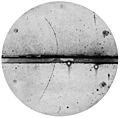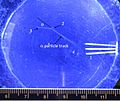Cloud chamber facts for kids
A cloud chamber is a special sealed box that helps scientists see tiny particles that are usually invisible. Imagine a box filled with a super-moist air, like a very steamy bathroom. When a tiny, electrically charged particle, such as an alpha particle or a beta particle, zooms through this moist air, it leaves a trail. This trail looks like a thin line of mist or fog, similar to the contrail left by a jet plane high in the sky.
These particles have a lot of energy, so they create a clear path of tiny charged spots (called ions) as they move. The mist then forms around these spots, making the particle's journey visible. Different types of particles leave different kinds of trails. For example, an alpha particle's trail is usually thicker and might show more bends from bumping into things. An electron's trail is thinner and straighter. If you add a strong magnetic field across the chamber, charged particles will curve in opposite directions depending on if they are positive or negative. This helps scientists figure out what kind of particle they are seeing.
Who Invented the Cloud Chamber?
The cloud chamber was invented by Charles Wilson, a Scottish physicist. He created the first one in 1911. For this amazing invention, he won the Nobel Prize in Physics in 1927.
This invention was very important in the early days of studying atomic physics, which is about the tiny parts that make up everything around us. People often called it the 'Wilson chamber' after him. Since then, many other tools have been invented to detect these tiny particles, but the cloud chamber was a big step forward!
Images for kids
-
Cloud chamber photograph of the first positron ever observed.
-
Fig. 1: Cloud chamber photograph used to prove the existence of the positron. Observed by C. Anderson.
See also
 In Spanish: Cámara de niebla para niños
In Spanish: Cámara de niebla para niños








